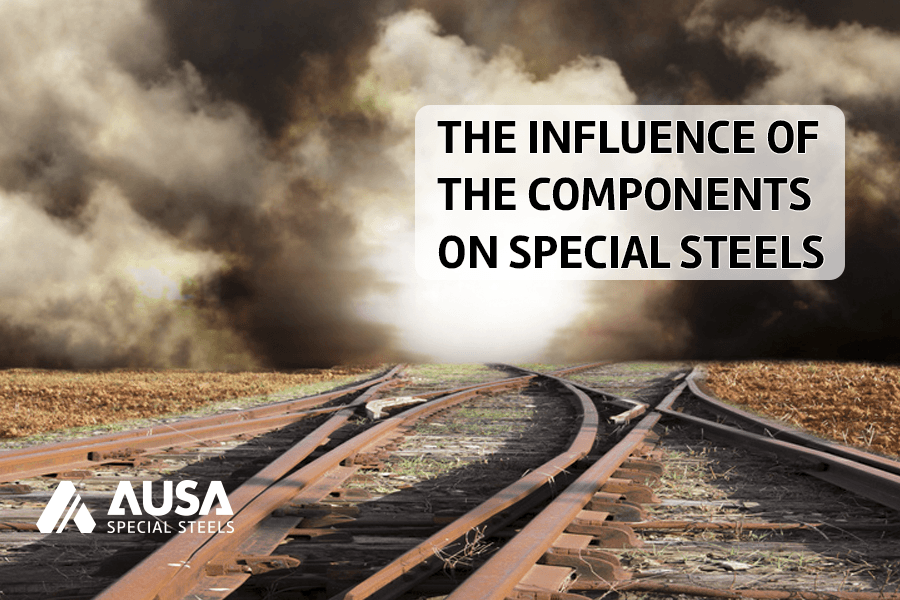Special steels are carbon steels that when alloyed with other metals have improved characteristics.
In the composition of special steels in addition to carbon, manganese and silicon there are other chemical elements that, in larger or smaller proportions, give it certain physical and chemical properties, which may be very important for their subsequent use.
The influence of the components on special steels
– Aluminium (Al): used in small amounts it acts as a deoxidising agent for cast steel and refines the austenitic grain size: the size of the crystals that compose the steel at temperatures of austenisation.
The grain of the steels is specified from number 1 for the coarsest grain to 8 for the finest. A good steel must have a grain size of 6 or above. It is an alloy element in nitrided steels.
– Sulphur (S): this is normally an impurity and is kept at a low level. Nevertheless, sometimes it is added intentionally in large amounts (0.06 to 0.30%) to increase the machinability of the carbon and alloy steels.
– Boron (B): added in insignificant amounts, considerably increases the quenchability of steels and increases the hardness of stainless steels in certain conditions.
– Carbon (C): this is an constituent element of steel that depending on the percentage in which it is added proportionally increases the resistance, the elastic limit and the hardness. It decreases the ductility and malleability.
– Zirconium (Zr): this is an element that deoxidises and decreases the grain size. It improves the deep drawing characteristics.
– Cobalt (Co): cobalt reduces the quenching depth. It increases the resistance to corrosion and abrasion. It provides greater tensile strength and a higher elastic limit.
– Copper (Cu): copper significantly improves the resistance to atmospheric corrosion. It makes steel brittle during forging and rolling, so it is not added as an alloy element. In cast items that do not have to be hot worked, it is added in order to increase the hardness. This increase in hardness is known as secondary hardening.
– Chrome (Cr): chromium increases the hardening depth and improves the resistance to wear and corrosion. At high temperatures, it increases the mechanical resistance. It inhibits the growth of the grain.
– Phosphorus (P): this is a poison for steel. For a steel to be of high quality, it must not contain more than 0.03%. It increases the resistance and hardness in the steels with a low carbon content, it slightly improves its resistance to corrosion, facilitates its machinability somewhat (the ability to be worked by cutting) and decreases its tenacity.
– Hydrogen (H): this is a harmful element. It causes brittleness in steel.
– Manganese (Mn): this is a basic element in all steels. It acts as a deoxidising agent and also neutralises the harmful effects of sulphur, facilitating rolling, mould making and other hot work. It also increases the penetration of quenching and contributes to its resistance and hardness. In high quantities, it increases the wear resistance.
– Molybdenum (Mo): by increasing the quenching penetration, it improves the properties of the heat treatment. It also increases the hardness and resistance to high temperatures. It counteracts the brittleness of tempering.
– Niobium (Nb): niobium refines the grain of steels. It increases its resilience at low temperatures. In low carbon content steels, it increases the resistance and elastic limit.
– Nickel (Ni): nickel raises the resistance of non-quenched steels and provides tenacity, especially at low temperatures. It improves its resistance to corrosion. When used jointly with chromium, it increases the hardness and wear resistance. It inhibits the grain growth of the steel when it is heated.
– Nitrogen (N): nitrogen controls the grain size. It increases the quenchability and increases the resistance of some stainless steels.
– Oxygen (O): oxygen is a harmful element. It increases the brittleness of steel and decreases its impact resistance.
– Lead (Pb): the addition of lead improves machinability.
– Silicon (Si): this is used as a deoxidising agent and improves the quenchability (the depth to which a steel can be hardened) in steels with non-gratifying elements. It increases the resistance of low-carbon steels.
– Tellurium (Te): alloyed to steel in minute proportions, it also improves its machinability.
– Titanium (Ti): this is used as a deoxidising agent and to inhibit grain growth. It also increases resistance to high temperatures. It prevents the loss of chromium in certain areas of stainless steels during very prolonged heating.
– Vanadium (V): in small quantities of around 0.10-0.12% maximum, it increases quenchability and refines the grain of the steel. It increases the resistance to impact (resistance to fracture due to impact) and also the resistance to fatigue. It improves the resistance in low-carbon steels.
– Wolfram or tungsten (W): this is used in many alloy steels for tools, giving them a high wear resistance and harnesses at high temperatures. It improves the hardness of steels at high temperatures.
The chemical elements phosphorus, sulphur, oxygen, nitrogen and hydrogen are susceptible to reduction during the fusion process.
Copper, arsenic, antimony and tin are components of scrap metal and are impossible to remove in the fusion process. The only defence against these elements consists of scrupulously selecting the scrap metal and using virgin materials.
Have you enjoyed reading this? If you liked it, join our community of subscribers. You will receive our content by e-mail every time we publish a post.
If you thought this was good, share this post with your friends on the social networks.








